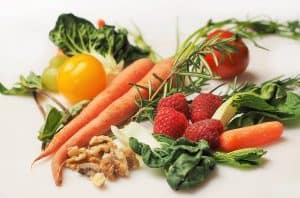Macronutrients
The substances required for energy, growth and functions of our body are called as nutrients. Nutrients are classified into macro nutrients and micro nutrients. Let us know about Macro nutrients. The nutrients required for energy, growth and functions of our body in large amounts are called as Macro nutrients. The macro nutrients required in significant quantities for daily activities to provide the energy (calories) are of 3 types: carbohydrates, proteins and fats.

Carbohydrates
Carbohydrates are the macro nutrients that our body requires in large amount in the form of sugar and starch. Carbohydrates are the main energy supply for our body and will be break down easily by our body.
Types of carbohydrates
Carbohydrates are divided into 2 categories:
Simple carbohydrates:
Simple carbohydrates are those with one or two sugar units are also known as sugarsand can be broken down quickly in the body. They include monosaccharides and disaccharides in the form of glucose, sucrose, fructose, lactose and maltose.
Examples of simple carbohydrates include:
- Fruits and fruit juices
- Milk and milk products
- Processed and refined sugars such as soft drinks and candy.
Complex carbohydrates
Complex carbohydrates are those with longer, more complex chains of sugars and can take longer time to digest and use in the body. They include oligosaccharides and polysaccharides and also contain fiber and starch.
Complex carbohydrates found in:
- Almost all plant foods contain complex carbohydrates.
- Vegetables and fruits
- Beans and dries peas
- Whole grains such as brown rice, wheat, corn, sorghum, barley, oats.
How the carbohydrates are utilized by body?
If we consume Carbohydrates, they break down into glucose which is a primary source of energy for our body. The metabolic reactions of a cell convert the glucose into ATP (Adenosine Tri-Phosphate), which is a form of cellular energy and utilized for instant energy and functions of the body. If the body doesn’t require more energy, the unused energy is is stored in the liver and as body fat for later use.
Role in the Body
- Fuel throughout high intensity exercise
- Spares protein (to preserve muscle mass throughout exercise)
- Fuel for the Central Nervous System (your brain)
- 1 gram of Carbohydrate contain 4 kcal
Proteins
Proteins are composed of 21 amino acids which are the building blocks of our body required to build, growth and repair of the tissues. Proteins are also required for hormonal, enzymatic, nutrients transportation, acid-base maintenance and to enhance immunity.
Types of amino acids
Out of the 21 amino acids, 9 are essential amino acids and will not be synthesized by our body but can be obtained through the diet. The remaining amino acids can be obtained through the diet and if not will be synthesized by liver.
Protein foods include:
Foods made from
- Peas
- Beans
- Nuts and seeds
- Beans
- Lentils
- whole grains
- Milk
- Low fat yogurt
- Cheese
- Eggs
- Poultry
- Meat
- Lean beef
- Seafood
How much protein required per day?
The daily requirement of protein per day may vary based on sex, age and activity level. The Recommended Dietary Allowance is 0.8 grams of protein per kilogram of body weight, or 0.36 grams per pound. 1 gm of Protein contain 4 kcal
Fats
Fats are one of the macro nutrients that you can get from your diet. Some amount of the fat in diet is essential, though it is also harmful to eat in more quantity leads to obesity, diabetes and cardiovascular diseases. 1 gram of fat contains 9 kcal.
Types of fat
Fats are of 3 types
- Unsaturated fats
- Saturated fats
- Trans fats
- Unsaturated fats
Unsaturated fats are considered as good fats because they minimize the risk of cardiovascular issues and improve blood cholesterol levels. The unsaturated foods will not be synthesized by your body but can be obtained through diet. Mostly unsaturated fats are available in foods from plants.
Unsaturated fats are of 2 types.
- Monounsatured fats are available in the following foods:
- Nuts and seeds such as peanuts, almonds, cashews, sesame seeds, watermelon seeds and pumpkin seeds.
- Vegetable oils
- Peanut butter and almond butter
- Polyunsaturated fats:
Omega – 3 fatty acids are an important type of polyunsaturated fat and can’t synthesized by body but can be obtained through food. The polyunsaturated fats are available in the following foods:
- Walnuts
- Flax seeds
- Chia seeds
- sunflower seeds
- soy beans
- sunflower, flaxseed and canola oil
- fish
- Saturated fats
Mostly saturated fats are available in foods from animals and dairy products include:
- chicken
- meat
- beef
- pork
- dairy foods (whole milk, butter, cheese, ice cream)
Saturated fats are also available in some plant foods such as coconut, coconut oil and palm oil. Eating too much saturated fat can increase blood cholesterol levels and LDL (bad) cholesterol levels.
- Trans fats
Trans-fats are the worst fats and available in foods that contain partially hydrogenated vegetable oils. The Trans fats can be found in:
- fried foods (French fries, doughnuts, deep-fried fast foods)
- baked goods (cakes, cookies, pastries, donuts)
- frozen foods (fried chicken, pizza)
- Processed snack foods (crackers, microwave popcorn) and packaged foods.
Trans fat can increase LDL cholesterol levels, known as bad cholesterol and also suppress HDL cholesterol levels, known as good cholesterol.

Prof. Venkata Kiran Kumar Mandlem is Head Of Department in CMR College of pharmacy Hyderabad . He Completed PhD in Pharmaceutical Sciences from Andhra University . More info about him MV Kiran Linkedin
